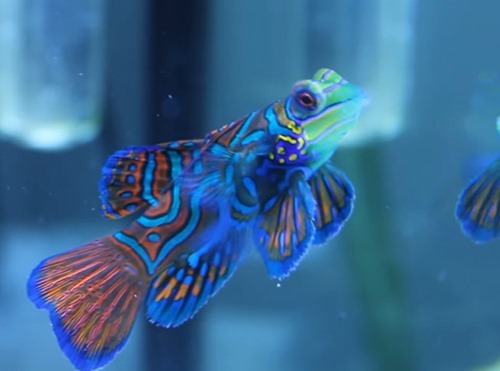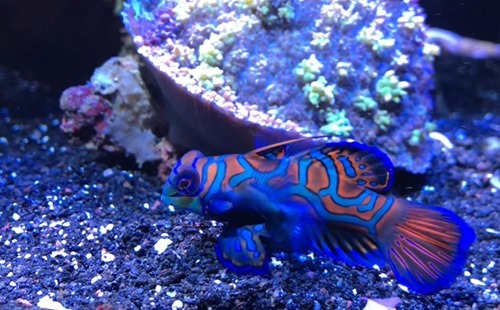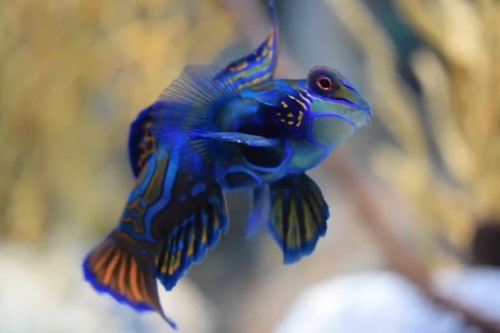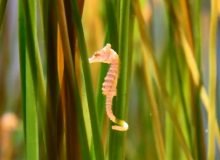Mandarin Goby Care Guide: How to Keep This Mesmerizing Thriving
Few marine fish capture the imagination like the mandarin goby. With its psychedelic colors, graceful movement, and almost mythical allure, it’s no wonder this species tops the wishlist of many saltwater aquarists. But behind that hypnotic beauty lies a delicate creature with very specific needs—and sadly, many perish in captivity due to misunderstandings about their care.
If you’re thinking of adding a mandarin goby to your tank, don’t let looks alone guide your decision. This is not your average beginner fish. Success with mandarins depends on careful planning, proper tank setup, and a deep understanding of their diet and behavior.
In this guide, we’ll walk you through everything you need to know—from choosing a healthy specimen to feeding, disease prevention, and stress-free handling—so that your mandarin goby not only survives, but thrives.
- Quick Care Stats
- Species Overview
- Appearance
- Tank Requirements
- Tank Setup
- Diet and Feeding
- Tank Mates
- How to Buy a Healthy Mandarin Goby
- Breeding
- Diseases & Treatment
- Frequently Asked Questions (FAQs)
Quick Care Stats
- Scientific Name: Synchiropus splendidus
- Common Name: Green Mandarin Goby, Mandarin Dragonet, Psychedelic Mandarin
- Origin: Western Pacific (Philippines, Indonesia, Australia, Japan)
- Max Length: 3 inches (8 cm)
- Minimum Tank: 30 gallons (113 liters)
- Stocking: 1 per 30–50 gallons; cautious with tankmates
- Temperament: Peaceful, shy
- Feeding: Carnivorous; live copepods, amphipods, supplemented with frozen foods
- Breeding: Egg-layer; difficult in captivity
- Habitat: Shallow lagoons, inshore reefs with live rock
- Tank Setup: Mature reef tank, live rock, live sand, low flow
- Active Tank Levels: Bottom to mid
- Temperature: 72–82°F (22–28°C)
- pH: 8.1–8.4
- Water Hardness: Specific gravity 1.023–1.025
- Lifespan: 3–4 years (up to 15 in ideal conditions)
Species Overview

Green Mandarin Gobies, part of the dragonet family (Callionymidae), inhabit the warm, shallow lagoons and inshore reefs of the Western Pacific, ranging from the Philippines to Australia and Japan to Indonesia. Their scaleless bodies and vivid coloration make them a standout in reef tanks, but their reliance on live prey like copepods and amphipods requires careful attention.
Measuring up to 3 inches (8 cm), these slow-moving, peaceful fish thrive in mature tanks (6–12 months old) with ample hiding spots and a robust food supply. Their unique “hopping” movement along the substrate, facilitated by fan-like pelvic fins, adds to their charm, though their specialized needs make them better suited for experienced aquarists.
Appearance
Green Mandarin Gobies are celebrated for their psychedelic, almost otherworldly appearance, which makes them a focal point in reef aquariums. Key features include:
- Base Color: A vibrant blue-green body adorned with wavy, maze-like patterns of orange, yellow, and blue, creating a kaleidoscopic effect that shimmers under aquarium lighting.
- Fins: Males have an elongated first dorsal spine, often raised during displays, with intricate orange-blue patterns. Females have shorter, less vivid fins without the extended spine. Both sexes have fan-like pelvic fins used for perching and “hopping” along the substrate.
- Body Shape: Their broad, elongated head and scaleless, smooth body give them a sleek profile. The scaleless skin secretes a noxious mucus, deterring predators and contributing to their vibrant sheen.
- Sexual Dimorphism: Males are brighter, with a prominent dorsal spine and more intense coloration. Females are duller, with subdued patterns and no dorsal spine extension, making sexing relatively straightforward.
- Size: Reaching up to 3 inches (8 cm), males are slightly larger and more robust, while females appear slimmer.
Additional Notes on Appearance
Their coloration is influenced by diet, tank maturity, and stress levels. A thriving copepod population and stable water conditions enhance their vivid blue-green and orange patterns, while stress or malnutrition can cause fading. Moderate lighting highlights their iridescence without overwhelming their shy nature.
Tank Requirements
A minimum tank size of 30 gallons is required for a single Green Mandarin Goby, with 50 gallons or more recommended for a male-female pair or community setups. Their slow feeding habits make them poor competitors, so stock cautiously, ensuring no more than one fish per 30–40 gallons with compatible tankmates. Stable marine water parameters are critical:
- Temperature: 72–82°F (22–28°C)
- pH: 8.1–8.4
- Specific Gravity: 1.023–1.025
- Ammonia/Nitrite: 0 ppm
- Nitrate: <10 ppm
A mature tank, at least 6–12 months old, with a thriving copepod and amphipod population is essential, as immature tanks cannot sustain their dietary needs. A tight-fitting lid is necessary to prevent jumping, especially during acclimation or when startled. Daily water testing with a marine-grade test kit and weekly 10–25% water changes using RO/DI water and a high-quality marine salt mix maintain pristine conditions, vital for their sensitive, scaleless bodies.
Tank Setup

Green Mandarin Goby/Dragonet
To mimic their natural lagoon and reef habitat, create a tank with abundant live rock and a live sand bed to support a natural copepod and amphipod population. Live rock provides foraging surfaces and hiding spots, while live sand fosters biodiversity. Include macroalgae like Chaetomorpha or Caulerpa in the main tank or a refugium to serve as pod refuges and enhance water quality. Coral rubble, caves, or crevices offer additional hiding spots, reducing stress for these shy fish.
Use a gentle filtration system, such as a sponge filter or low-flow canister filter, to replicate their calm lagoon environment, as strong currents can hinder their foraging. A reliable heater maintains stable temperatures, as fluctuations can weaken their immune system. Moderate LED lighting supports macroalgae growth and highlights their colors without causing stress. Regularly seed the tank with copepods (e.g., Tisbe or Tigriopus species) to ensure a sustainable food supply, especially in smaller or newer systems.
Additional Setup Considerations
- Refugium: A refugium (5–10 gallons) connected to the main tank is highly recommended to cultivate copepods and amphipods, ensuring a steady food supply.
- Maintenance: Siphon uneaten food and debris weekly to prevent fouling, as live sand and rock can trap waste. Trim macroalgae to prevent overgrowth while preserving pod habitats.
- Tank Stability: Avoid frequent substrate disturbances, as they disrupt the micro-fauna population critical for the goby’s diet.
Diet and Feeding
Green Mandarin Gobies are obligate carnivores, primarily grazing on live copepods and amphipods found on live rock and sand in their natural habitat. Their specialized diet is the primary challenge in captivity. Recommended foods include:
Live Foods: Copepods (e.g., Tisbe, Tigrigrid, Apocyclops) and amphipods are their primary food source, foraged continuously from live rock and sand. A mature tank with a robust pod population is essential to sustain them.
Frozen Foods: Captive-bred mandarins may accept frozen mysis shrimp, brine shrimp, or copepods, though wild-caught fish often refuse non-living foods. Train them using a feeding station with gentle water flow to mimic live prey movement. Success varies, so live foods remain critical.
Supplements: Add phytoplankton (e.g., Isochrysis or Tetraselmis) to the tank or refugium to boost copepod reproduction, ensuring a sustainable food supply. Vitamin-enriched frozen foods can enhance nutrition if accepted.
Feeding Frequency: Feed 2–3 times daily, allowing 1–2 minutes of consumption per session to avoid water fouling. Target-feed live copepods near foraging areas to supplement natural grazing.
Feeding Tips
- Pod Culture: Maintain a separate copepod culture tank (2–5 gallons) or purchase live pods regularly to seed the main tank, as gobies can deplete natural populations.
- Observe Feeding: Monitor for active foraging (e.g., pecking at substrates) and ensure no signs of starvation (sunken belly, visible abdominal lines). If pods are scarce, increase seeding frequency or add a refugium.
- Avoid Overfeeding: Remove excess food waste promptly to prevent ammonia spikes, which are particularly harmful to their scaleless skin.
A mature tank with a thriving copepod population is critical to prevent starvation, ensuring long-term health and vibrant coloration.
Tank Mates
Behavior and Temperament
Green Mandarin Gobies are peaceful, shy, and slow-moving, spending most of their time foraging along the tank bottom or perching on live rock. They secrete a noxious mucus coating that deters predators, making them safe from most tankmates. Males are territorial and may fight with other male mandarins, so keep only one male per tank or a mated male-female pair. Their slow feeding habits make them vulnerable to competition, requiring tankmates that do not consume copepods aggressively. Their deliberate, almost hypnotic movements add tranquility to reef setups.
Suitable Tankmates
Choose non-aggressive, reef-safe species that do not compete for copepods or disrupt the goby’s foraging. Ideal tankmates include:
- Fish: Small, peaceful reef fish like clownfish (Amphiprion spp.), small gobies (e.g., Eviota spp.), firefish, or dwarf angelfish (e.g., Centropyge spp.). These species occupy different tank levels and have minimal dietary overlap.
- Invertebrates: Cleaner shrimp (e.g., Lysmata amboinensis), peppermint shrimp, or snails (e.g., nerite, trochus) are safe and beneficial, aiding in tank maintenance. Soft corals (e.g., Xenia, Clavularia) and non-stinging LPS corals are compatible.
- Avoid: Copepod-eating competitors like wrasses (e.g., Halichoeres spp.), hawkfish, or large blennies, which can deplete the goby’s food supply. Avoid aggressive fish like triggerfish or puffers, which may harass or eat mandarins.
Tankmate Considerations
- Ensure a robust copepod population before adding tankmates, as competition can starve mandarins. Larger tanks (50+ gallons) support more diverse communities without food shortages.
- Monitor interactions during introductions, as mandarins may retreat if overwhelmed by active tankmates. Provide ample hiding spots to reduce stress.
- Avoid overcrowding, as high bioloads degrade water quality, which is particularly harmful to scaleless fish like mandarins.
How to Buy a Healthy Mandarin Goby

When shopping for a mandarin goby, the most important question to ask the seller is: “Is this fish eating frozen food?” If the answer is yes, kindly ask them to demonstrate by feeding the fish in front of you. A healthy mandarin will actively peck at the food. If the fish refuses to eat—and you don’t have a thriving copepod population in your tank to sustain it—it’s best to walk away.
Mandarin gobies are beautiful and relatively hardy, but only if they’re eating well. In tanks with abundant live pods, they’re considered low-maintenance and resistant to many common diseases. However, their specialized diet makes them unsuitable for new or unprepared aquarists.
Avoid fish that appear emaciated—sunken bellies and thin bodies are red flags. While it might be tempting to “rescue” a starving mandarin, the sad reality is that such fish often don’t survive, despite your best efforts.
When stressed or frightened, mandarins secrete a surprising amount of thick, gel-like slime. It’s a natural defense mechanism, but can create a mess and stress the fish further. Try to minimize disturbances to avoid triggering this response.
If you need to move your mandarin, avoid using a net. Instead, gently coax it into a small container and transfer the container—fish and all—into the new tank. This reduces stress and prevents damage to its delicate body.
Although mandarins are naturally resistant to many diseases, they can still contract marine ich (Cryptocaryon irritans). Due to their lack of protective scales, copper-based treatments are unsafe. Instead, treat with hyposalinity, a safer and more effective option for this species.
Breeding
Preparation for Breeding
Breeding Green Mandarin Gobies in captivity is rare and extremely challenging due to their specialized dietary needs and the difficulty of raising planktonic larvae. Set up a dedicated 50-gallon breeding tank with abundant live rock, macroalgae (e.g., Chaetomorpha), and stable water parameters:
- Temperature: 75–80°F (24–27°C)
- pH: 8.1–8.3
- Specific Gravity: 1.023–1.024
- Water Quality: Ammonia and nitrite at 0 ppm, nitrates below 10 ppm.
Condition a mated pair (identifiable by the male’s dorsal spine and courtship behavior) with abundant live copepods and amphipods for 2–4 weeks to enhance health and spawning readiness. Use a gentle sponge filter to maintain water quality without disturbing eggs or larvae, and ensure a secure lid to prevent jumping. Dim lighting and ample hiding spots reduce stress during courtship.
Breeding Process
Males initiate courtship with a dramatic mating dance, raising their dorsal spine and swimming in synchronized spirals with the female. At dusk, the pair rises into the water column, releasing eggs and sperm simultaneously in open water. The eggs are planktonic, tiny, and buoyant, drifting with currents and making them nearly impossible to collect in a home aquarium. A single spawn can produce hundreds of eggs, but breeding success is rare due to the difficulty of maintaining larvae. To attempt rearing, siphon eggs into a separate larval tank immediately after spawning, though most aquarists leave eggs in the main tank, where they are typically consumed or lost.
Caring for Fry
Larvae are extremely delicate, requiring a specialized rearing tank and precise care:
- Initial Feeding: For the first 7–10 days, feed live rotifers (Brachionus spp.) and copepod nauplii, enriched with phytoplankton. After 10–14 days, transition to larger copepods and newly hatched brine shrimp as they grow.
- Nursery Tank: Use a 10–20-gallon bare-bottom tank with gentle aeration and blacked-out sides to keep larvae near the surface. Maintain identical water parameters to the breeding tank, with daily 10% water changes using RO/DI water and marine salt mix.
- Growth and Development: Larvae are highly sensitive, with low survival rates in home aquariums. They settle to the substrate after 3–4 weeks, resembling miniature adults. Provide constant live food and monitor for fungal infections or starvation.
Raising fry is nearly impossible for most hobbyists due to the need for a continuous supply of microscopic live foods and pristine water conditions.
Diseases & Treatment
Green Mandarin Gobies are hardy when well-fed and housed in a mature tank but are prone to starvation in inadequate setups. Common health issues and treatments include:
- Starvation: Symptoms include a sunken belly, visible abdominal lines, or lethargy, caused by insufficient copepods or competition. Ensure a robust pod population by seeding the tank regularly and using a refugium. Consider captive-bred mandarins, which are more likely to accept frozen foods. Target-feed live copepods until recovery is observed.
- Ich (White Spot Disease): White spots on the body or fins, scratching, or rapid gill movement indicate ich. Treat in a quarantine tank with copper-based medications (e.g., Seachem Cupramine) at therapeutic levels, as mandarins are sensitive to some treatments. Maintain copper levels per instructions and avoid treating in the main tank to protect copepods. Increase aeration and perform 25% water changes in the quarantine tank.
- Bacterial Infections: Lethargy, cloudy patches, or skin lesions suggest bacterial issues, often linked to poor water quality or starvation stress. Improve water conditions with 20–25% water changes and treat with marine-safe antibiotics (e.g., Seachem Kanaplex) in a quarantine tank, following dosage instructions. Remove carbon from filters during treatment.
- Stress: Faded colors, hiding, or reduced foraging indicate stress, often due to inadequate food, aggressive tankmates, or unstable parameters. Test and stabilize water parameters, increase copepod seeding, and ensure ample hiding spots. Remove competitive tankmates if necessary.
Prevention
Prevent health issues with diligent care:
- Maintain a mature tank with a thriving copepod population, seeding regularly to sustain food availability.
- Perform weekly 10–25% water changes using RO/DI water and a marine salt mix to keep water pristine.
- Test water parameters daily with a marine test kit to ensure stability, particularly specific gravity, ammonia, and nitrates.
- Quarantine new fish or invertebrates for 2–4 weeks to avoid introducing pathogens, as mandarins are sensitive to disease.
- Minimize stress by avoiding sudden lighting changes, loud noises, or aggressive tankmates.
Regular observation and a robust food supply are critical to keeping Green Mandarin Gobies healthy and vibrant.
Frequently Asked Questions (FAQs)
Q: Can Green Mandarin Gobies live in a small nano tank?
A: A 30-gallon minimum is recommended due to their need for a large, sustainable copepod population. Smaller tanks risk starvation and are unsuitable for their long-term health.
Q: Do they eat frozen foods?
A: Captive-bred mandarins may accept frozen mysis shrimp, brine shrimp, or copepods, but wild-caught fish typically require live copepods. Training to accept frozen foods requires patience and a feeding station.
Q: Are Green Mandarin Gobies beginner-friendly?
A: No, their specialized diet and need for a mature tank with a robust copepod population make them best suited for experienced marine aquarists.
Q: Can I keep multiple Green Mandarin Gobies?
A: A male-female pair can coexist in a 50-gallon or larger tank with ample food and hiding spots, but multiple males may fight. Ensure a thriving copepod population to support multiple mandarins.
Q: How long do Green Mandarin Gobies live?
A: With proper care, including a steady food supply and stable water conditions, they can live 2–6 years, though starvation often shortens lifespans in inadequate setups.
Q: Are Green Mandarin Gobies safe with corals?
A: Yes, they are reef-safe and do not harm corals. Soft corals and non-stinging LPS corals provide additional perching spots, enhancing their environment.
Q: How do I ensure enough copepods for my Green Mandarin Goby?
A: Maintain a mature tank with live rock and sand, seed regularly with live copepods (e.g., Tisbe, Tigriopus), and use a refugium to cultivate pods. Monitor foraging to confirm adequate food availability.


Leave a Reply